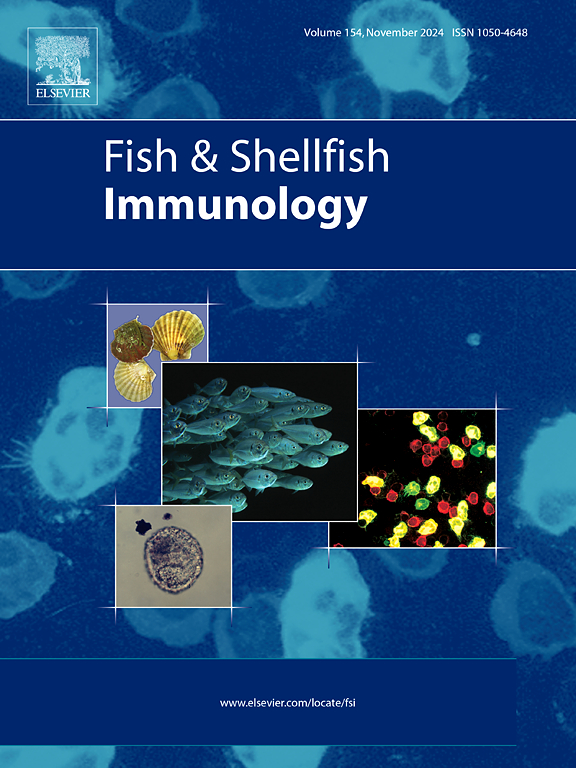The study of MDM2 binding protein (MTBP) in response to apoptosis in Litopenaeus vannamei under ammonia and nitrite nitrogen stress
IF 3.9
2区 农林科学
Q1 FISHERIES
引用次数: 0
Abstract
MDM2 binding protein (MTBP) is a protein that interacts directly with MDM2. This study characterized the LvMTBP, revealing a 2752 bp cDNA sequence encoding an 834-amino acid hydrophilic protein with conserved MTBP_N and MTBP_C domains. Phylogenetic analysis demonstrated close evolutionary relationships with Penaeus species. LvMTBP exhibited ubiquitous tissue expression, with highest levels in muscle. Under ammonia and nitrite nitrogen stress, LvMTBP expression was downregulated in gills and muscle. RNAi experiments showed that LvMTBP knockdown dramatically reduced shrimp survival rates under both stress conditions. Histopathological examination revealed severe tissue damage in hepatopancreas and gills following LvMTBP silencing. Mechanistic investigations demonstrated that LvMTBP depletion activated the p53-mediated mitochondrial apoptosis pathway, evidenced by upregulated Bax, p53, and Caspase 9 expression, downregulated Bcl-2 and MDM2, and increased Caspase-3 activity. Apoptosis assays confirmed higher apoptotic indices in LvMTBP-knockdown groups. Complementary experiments in HEK293T cells showed MTBP overexpression reduced apoptosis rates, supporting its anti-apoptotic function. These findings establish LvMTBP as a crucial regulator of environmental stress responses in L. vannamei, functioning through modulation of the p53-MDM2 axis and apoptosis pathways. The study provides newly identified insights into crustacean stress adaptation mechanisms and suggests LvMTBP as a potential molecular target for improving shrimp tolerance in aquaculture systems.
氨氮和亚硝酸盐氮胁迫下凡纳滨对虾MDM2结合蛋白(MTBP)对细胞凋亡的响应研究
MDM2结合蛋白(MTBP)是一种直接与MDM2相互作用的蛋白。该研究对LvMTBP进行了鉴定,发现了一个2752 bp的cDNA序列,编码一个834个氨基酸的亲水蛋白,具有保守的MTBP_N和MTBP_C结构域。系统发育分析表明与对虾属有密切的进化关系。LvMTBP在组织中普遍表达,在肌肉中表达水平最高。在氨氮和亚硝酸盐氮胁迫下,lvtnbp在鳃和肌肉中的表达下调。RNAi实验表明,在两种应激条件下,lvtnbp基因敲除显著降低了虾的存活率。组织病理学检查显示,lvtbp沉默后肝胰腺和鱼鳃组织严重损伤。机制研究表明,LvMTBP缺失激活了p53介导的线粒体凋亡途径,表现为Bax、p53和Caspase 9表达上调,Bcl-2和MDM2下调,Caspase-3活性升高。细胞凋亡实验证实,lvmtbp敲低组的细胞凋亡指数较高。在HEK293T细胞中的补充实验显示,MTBP过表达可降低细胞凋亡率,支持其抗凋亡功能。这些研究结果表明,lvtnbp通过调节p53-MDM2轴和细胞凋亡途径,在南美扁豆的环境应激反应中发挥重要调节作用。该研究为甲壳类动物的应激适应机制提供了新的见解,并表明LvMTBP是提高水产养殖系统对虾耐受性的潜在分子靶点。
本文章由计算机程序翻译,如有差异,请以英文原文为准。
求助全文
约1分钟内获得全文
求助全文
来源期刊

Fish & shellfish immunology
农林科学-海洋与淡水生物学
CiteScore
7.50
自引率
19.10%
发文量
750
审稿时长
68 days
期刊介绍:
Fish and Shellfish Immunology rapidly publishes high-quality, peer-refereed contributions in the expanding fields of fish and shellfish immunology. It presents studies on the basic mechanisms of both the specific and non-specific defense systems, the cells, tissues, and humoral factors involved, their dependence on environmental and intrinsic factors, response to pathogens, response to vaccination, and applied studies on the development of specific vaccines for use in the aquaculture industry.
 求助内容:
求助内容: 应助结果提醒方式:
应助结果提醒方式:


